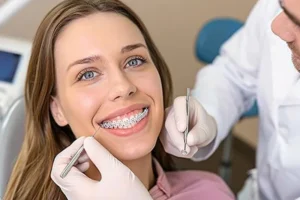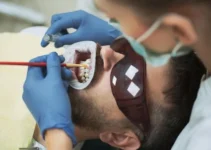Many adults might think that they missed their chance to correct their smile with orthodontics, believing it’s predominantly for children or teenagers. However, adult orthodontics has become increasingly popular, proving that it’s indeed never too late to enhance your smile. Whether it’s for cosmetic reasons or to correct alignment issues that can cause dental health problems, modern braces and other orthodontic treatments are designed to be less noticeable and more comfortable than ever before. This adaptation not only makes them aesthetically pleasing but also expands the opportunity for adults to improve their dental health and boost their confidence.
Why Orthodontics is Important for Adults
Orthodontic treatments are not just for children and teenagers; adults can also benefit greatly from these procedures. Misaligned teeth and jaws can lead to a variety of dental and overall health issues if left untreated. Advancements in orthodontic technology now offer subtle and effective ways to transform your smile at any age. Understanding the importance of orthodontics for adults can help you make an informed decision about your dental health.
One of the primary reasons adults seek orthodontic treatment is to address long-standing dental issues that were never corrected in their younger years. Crooked or crowded teeth can cause a range of problems, from difficulties in maintaining oral hygiene to increased risk of gum disease and tooth decay. By choosing to undergo orthodontic treatment, adults can not only improve their appearance but also their overall oral health.
Moreover, with the availability of discreet options such as clear aligners and lingual braces, more adults are choosing to invest in their smiles. These modern solutions allow for effective treatment without the visibility of traditional metal braces, making orthodontics a viable option for adults concerned about appearance during the treatment process.
Health Benefits of Adult Orthodontics
Correcting misaligned teeth and jaws can lead to significant health benefits. One of the most immediate advantages is the improvement in oral hygiene. Crowded or twisted teeth create spaces that are difficult to clean effectively, leading to a build-up of plaque and an increased risk of decay and gum disease. Orthodontic treatments align the teeth properly, making it easier to brush and floss thoroughly.
Additionally, properly aligned teeth can alleviate issues related to jaw pain and temporomandibular joint (TMJ) disorders. Misalignment of the bite can cause chronic discomfort, headaches, and even neck pain. By aligning the teeth and jaw correctly, many patients find relief from these persistent issues.
There are also systemic health benefits to consider. Studies have shown that poor oral health can be linked to a range of other health issues, including diabetes, heart disease, and respiratory problems. By improving your oral health through orthodontic treatments, you can potentially reduce the risk of these systemic conditions.
Aesthetics and Confidence
One of the most evident benefits of orthodontics is the improvement in appearance and confidence. A straight, well-aligned smile can significantly enhance one’s appearance, leading to greater self-esteem and confidence. This boost in confidence can have a positive impact on various aspects of life, from personal relationships to professional opportunities.
Adults who were unhappy with their smiles in their younger years often report that undergoing orthodontic treatment has been life-changing. The ability to smile confidently without feeling self-conscious is a powerful motivator for many people seeking orthodontic care. Moreover, the availability of modern orthodontic appliances means that adults can achieve these aesthetic benefits without the embarrassment often associated with traditional braces. Options such as clear aligners and ceramic braces blend seamlessly with your natural teeth, providing effective treatment without drawing attention.
Functional Improvements
Beyond the aesthetic and health benefits, orthodontic treatment also offers significant functional improvements. Proper alignment of the teeth and jaws facilitates more efficient biting, chewing, and speaking. Misaligned teeth can cause difficulty in these essential functions, leading to discomfort and inefficiency.
In addition, orthodontic treatment can prevent excessive wear and tear on the teeth. When the bite is misaligned, certain teeth may experience more pressure and friction than others. Over time, this can lead to chipping, cracking, or excessive wear. By ensuring that the teeth meet correctly, orthodontics can help prevent these issues and prolong the life of your natural teeth.
Lastly, proper alignment can also aid in resolving digestive issues. Efficient chewing is the first step in the digestive process. Misaligned teeth can hinder this, leading to inadequate breaking down of food and subsequent digestive discomfort. By improving how the teeth function together, orthodontics can contribute to better overall digestion. In conclusion, the importance of orthodontics for adults spans a range of benefits from improved health and appearance to enhanced functionality. If you’re considering orthodontic treatment, these comprehensive advantages highlight why it’s never too late to invest in your smile. For more in-depth information on other related topics, be sure to explore our additional articles.
Types of Orthodontic Treatments for Adults
Orthodontic treatments are not just for children and teenagers; many adults seek to improve their dental health and smile aesthetics. Advances in dental technology have made orthodontic treatments more accessible and varied, catering to the unique needs and preferences of adults. Understanding the different types of orthodontic treatments available can help in making an informed decision about which method is best suited for individual needs.
Choosing the right orthodontic treatment requires considering factors such as the severity of the dental issue, lifestyle, and budget. Here, we will explore three popular orthodontic treatment options for adults: traditional braces, clear aligners, and lingual braces.
Traditional Braces
Traditional braces are a time-proven orthodontic treatment that uses metal brackets and wires to correct dental misalignments. They are effective for treating a wide range of dental issues, from minor crowding to severe malocclusions. The system works by applying continuous pressure on the teeth, gradually moving them into the desired position.
Modern advances have made traditional braces less conspicuous and more comfortable than before. Options such as ceramic brackets, which blend with the natural color of teeth, make them more aesthetically pleasing. Traditional braces are often recommended for more complex orthodontic cases because they offer precise control over tooth movement.
Despite their effectiveness, traditional braces come with some considerations. They require regular adjustments and diligent oral hygiene to prevent plaque build-up around the brackets and wires. Additionally, certain foods must be avoided to prevent damage to the braces, making them a less convenient option for some adults.
Clear Aligners
Clear aligners, commonly known by the brand name Invisalign, are a popular choice among adults for orthodontic treatment. These aligners are custom-made, transparent, and nearly invisible, making them an aesthetically pleasing option for correcting dental issues. Clear aligners are typically used to treat mild to moderate orthodontic problems such as gaps, crowding, and minor bite issues.
The treatment process involves a series of aligners that are worn for about 20-22 hours a day and changed every one to two weeks. Each set of aligners gradually moves the teeth toward the desired position. One of the significant advantages of clear aligners is their removability, allowing for easier eating and cleaning compared to traditional braces.
However, the success of clear aligners depends heavily on patient compliance. Since they are removable, there is a risk of not wearing them as recommended, which can delay treatment. Regular check-ups with the orthodontist are necessary to monitor progress and make any necessary adjustments.
Lingual Braces
Lingual braces offer a unique solution for adults who require the effectiveness of traditional braces but prefer a more discreet option. These braces are placed on the inner surfaces of the teeth, making them virtually invisible from the outside. Lingual braces function similarly to traditional braces, using brackets and wires to move teeth into the desired position.
One of the main advantages of lingual braces is their invisibility, making them an excellent option for adults concerned about the aesthetics of orthodontic treatment. They are also effective for a wide range of orthodontic issues, including complex cases.
However, lingual braces can be more challenging to clean and adjust compared to traditional braces. They may also cause temporary discomfort and speech difficulties as the tongue adjusts to the brackets. Despite these challenges, many adults find the aesthetic benefits well worth the effort.
Choosing the right orthodontic treatment involves understanding the pros and cons of each option. For more information on optimizing your dental health and treatment outcomes, consider reading our other articles on advanced orthodontic techniques and patient care tips.
The Process and What to Expect
Understanding the process of dental implants and what to expect can help alleviate any concerns you might have. The journey to a restored smile involves several stages, each crucial for ensuring the success of the implants. Let’s delve into the main steps involved from the initial consultation to ongoing maintenance.
Dental implants are a modern solution for tooth loss, designed to be a long-term or permanent replacement. These implants provide more than just aesthetic benefits; they offer functional advantages that can significantly improve your quality of life. By exploring each phase of the implant process, you can prepare yourself mentally and physically for this transformative experience.
Initial Consultation
The initial consultation is the foundation of your dental implant journey. During this first visit, your dentist will conduct a thorough examination of your oral health. This may include taking X-rays, CT scans, and dental impressions to gather a complete picture of your dental structure.
Your dentist will also discuss your medical history, current medications, and any underlying health conditions that might affect the implant process. It’s important to be honest and comprehensive about your health to ensure the best outcomes.
In addition to the examination, this consultation is an opportunity for you to ask questions. It’s crucial to understand the procedure, potential risks, and benefits. Your dentist will explain the entire process, from the surgical placement of the implant to the final restoration.
Treatment Planning
Once the initial consultation is complete, your dentist will create a personalized treatment plan. This plan will detail the specific steps and timelines tailored to your unique situation. The treatment plan includes the number of implants needed, the type of implants, and the restoration process.
A tailored treatment plan is essential as it considers factors such as the quality and quantity of your jawbone, the position of surrounding teeth, and your overall health. In some cases, bone grafting may be required to ensure there is enough bone to support the implant.
Your dentist will also factor in your aesthetic goals. The aim is not only to restore function but also to achieve a natural-looking smile. The treatment plan ensures all these aspects are addressed systematically.
Ongoing Maintenance and Care
After the completion of your dental implant procedure, ongoing maintenance and care are vital to ensure the longevity of your implants. Regular dental check-ups are essential to monitor the health of your gums and the integrity of the implants.
Oral hygiene practices are more important than ever. Brushing twice a day, flossing, and using an antiseptic mouthwash can help prevent infections and maintain the health of your surrounding natural teeth. It’s crucial to follow your dentist’s recommendations on oral care products.
Dietary habits also play a role in the longevity of your implants. Avoiding hard or sticky foods can prevent damage. Additionally, quitting smoking is advised, as it can negatively impact the healing process and overall success of the implants.
In summary, the dental implant process is a meticulously planned journey that requires cooperation between you and your dental team. By understanding each phase, you can ensure a smooth process and successful outcome. For more detailed insights into each aspect of dental health, explore our other articles and stay informed.
FAQs About Adult Orthodontics
Many adults wonder if it’s too late to transform their smile through orthodontics. Here are commonly asked questions that can shed some light on the topic.
Can adults benefit from orthodontic treatments?
Yes, adults can significantly benefit from orthodontic treatments. With advances in orthodontic technology, treatments are more comfortable and less noticeable than ever, making them suitable for adults. Aligning teeth can improve oral health and functionality, aside from enhancing the aesthetic appearance of the smile.
Are there less visible orthodontic options available for adults?
Indeed, there are several discreet orthodontic treatments available for adults who are concerned about the aesthetic impact of traditional braces. Options include clear aligners like Invisalign, lingual braces that are placed on the back of the teeth, and ceramic braces that are designed to blend in with the natural color of the teeth.

My name is Salman Kapa, a 73-year-old expert in bone regeneration and dental implantology. With decades of experience in the field, I am dedicated to advancing our understanding of oral health and hygiene. Through my research and writing, I aim to contribute to the development of innovative solutions in dental care.




